Exploratory Analysis of Physiological and Biomechanical Determinants of CrossFit Benchmark Workout Performance: The Role of Sex and Training Experience
Abstract
1. Introduction
2. Materials and Methods
2.1. Procedures
2.1.1. Baseline Anthropometry and Resting Heart Rate
2.1.2. Squat Jump (SJ) and Countermovement Jump (CMJ)
2.1.3. Workout of the Day (WOD), Respiratory Gas Exchange and Heart Rate Evaluation
2.1.4. Blood Lactate
2.2. Statistical Analysis
3. Results
3.1. Descriptive Statistics
3.2. Comparisons Between Sex and Experience
3.3. Associations with WOD Performance
4. Discussion
5. Limitations
6. Conclusions
Author Contributions
Funding
Institutional Review Board Statement
Informed Consent Statement
Data Availability Statement
Acknowledgments
Conflicts of Interest
References
- Mangine, G.; Tankersley, J.; McDougle, J.; Velazquez, N.; Roberts, M.; Esmat, T.; Feito, Y. Predictors of CrossFit Open Performance. Sports 2020, 8, 102. [Google Scholar] [CrossRef] [PubMed]
- Jacob, M.; Keiner, M.; Holmberg, H.C.; Häkkinen, K. Physiological Responses to CrossFit® Training: A Systematic Review. Front. Physiol. 2020, 11, 1001. [Google Scholar] [CrossRef] [PubMed]
- Dexheimer, J.D.; Schroeder, E.T.; Sawyer, B.J.; Pettitt, R.W.; Aguinaldo, A.L.; Torrence, W.A. Physiological Performance Measures as Indicators of CrossFit® Performance. Sports 2019, 7, 93. [Google Scholar] [CrossRef] [PubMed]
- Camacho-Cardenosa, A.; Timón, R.; Camacho-Cardenosa, M.; Guerrero-Flores, S.; Olcina, G.; Marcos-Serrano, M. Six-Months CrossFit Training Improves Metabolic Efficiency in Young Trained Men. Cult. Cienc. Deporte 2020, 15, 421–427. [Google Scholar] [CrossRef]
- DeBlauw, J.; Drake, N.; Kurtz, B.; Crawford, D.; Carper, M.; Wakeman, A.; Heinrich, K. High-Intensity Functional Training Guided by Individualized Heart Rate Variability Results in Similar Health and Fitness Improvements as Predetermined Training with Less Effort. J. Funct. Morphol. Kinesiol. 2021, 6, 102. [Google Scholar] [CrossRef]
- Forte, L.D.M.; Freire, Y.G.C.; Júnior, J.S.S.; Melo, D.A.; Meireles, C.L.S. Physiological Responses after Two Different CrossFit Workouts. Biol. Sport 2022, 39, 231–236. [Google Scholar] [CrossRef]
- Toledo, R.; Dias, M.; Toledo, R.; Erotides, R.; Pinto, D.; Reis, V.; Heinrich, K. Comparison of Physiological Responses and Training Load between Different CrossFit Workouts with Equalized Volume in Men and Women. Life 2021, 11, 586. [Google Scholar] [CrossRef]
- Fernández, J.F.; Solana, R.S.; Moya, D.; Marin, J.M.; Sáez de Villarreal, E. Acute Physiological Responses during CrossFit® Workouts. Eur. J. Hum. Mov. 2015, 35, 114–124. Available online: https://www.eurjhm.com/index.php/eurjhm/article/view/362 (accessed on 14 September 2025).
- Leitão, L.; Dias, M.R.; Campos, Y.; Vieira, J.G.; Sant’Ana, L.O.; Telles, L.G.S.; Vianna, J.M. Physical and Physiological Predictors of Fran CrossFit WOD Athlete’s Performance. Int. J. Environ. Res. Public Health 2021, 18, 4070. [Google Scholar] [CrossRef]
- Zeitz, E.; Cook, L.; Dexheimer, J.D.; Lemez, S.; Leyva, W.D.; Terbio, I.Y.; Jo, E. The Relationship between CrossFit Performance and Laboratory-Based Measurements of Fitness. Sports 2020, 8, 112. [Google Scholar] [CrossRef]
- Sanfilippo, J.; Krueger, D.; Heiderscheit, B.C.; Binkley, N. Dual-Energy X-ray Absorptiometry Body Composition in NCAA Division I Athletes: Exploration of Mass Distribution. Sports Health 2019, 11, 453–460. [Google Scholar] [CrossRef]
- Rios, M.; Cardoso, R.; Reis, M.R.; Moreira-Gonçalves, D.; Pyne, B.D.; Fernandes, J.R. Sex-Related Differences in the Acute Physiological Response to a High-Intensity CrossFit Workout. Physiology 2025, 8, 100148. [Google Scholar] [CrossRef]
- Rios, M.; Becker, K.M.; Monteiro, A.S.; Fonseca, P.; Pyne, D.B.; Reis, V.M.; Fernandes, R.J. Effect of the Fran CrossFit Workout on Oxygen Uptake Kinetics, Energetics, and Postexercise Muscle Function in Trained CrossFitters. Int. J. Sports Physiol. Perform. 2024, 19, 299–306. [Google Scholar] [CrossRef] [PubMed]
- Senefeld, J.; Hunter, S. Hormonal Basis of Biological Sex Differences in Human Athletic Performance. Endocrinology 2024, 165, bqae036. [Google Scholar] [CrossRef] [PubMed]
- Archacki, D.; Zieliński, J.; Ciekot-Sołtysiak, M.; Zarębska, E.; Kusy, K. Sex Differences in the Energy System Contribution during Sprint Exercise in Speed-Power and Endurance Athletes. J. Clin. Med. 2024, 13, 4812. [Google Scholar] [CrossRef] [PubMed]
- Tucker, M.A.; Lee, N.; Rodriguez-Miguelez, P.; Looney, J.; Crandall, R.; Forseen, C.; Harris, R.A. Exercise Testing in Patients with Cystic Fibrosis—Importance of Ventilatory Parameters. Eur. J. Appl. Physiol. 2019, 119, 227–234. [Google Scholar] [CrossRef]
- Qiu, S.; Alzhab, S.; Picard, G.; Taylor, J.A. Ventilation Limits Aerobic Capacity after Functional Electrical Stimulation Row Training in High Spinal Cord Injury. Med. Sci. Sports Exerc. 2016, 48, 1111–1118. [Google Scholar] [CrossRef]
- Woo, J.; Derleth, C.L.; Stratton, J.R.; Levy, W.C. The Influence of Age, Gender, and Training on Exercise Efficiency. J. Am. Coll. Cardiol. 2006, 47, 1049–1057. [Google Scholar] [CrossRef]
- Weiss, E.P.; Spina, R.J.; Holloszy, J.O.; Ehsani, A.A. Gender Differences in the Decline in Aerobic Capacity and Its Physiological Determinants during the Later Decades of Life. J. Appl. Physiol. 2006, 101, 938–944. [Google Scholar] [CrossRef]
- Rodrigues, A.; Resende, R.; Pogetti, L.; Santos, T.; Faria, H.; Chagas, M.; Ocarino, J. Trunk, Mass Grasp, Knee, and Hip Muscle Performance in CrossFit Participants: Reference Values According to Participants’ Sex and Limb Dominance. Int. J. Sports Phys. Ther. 2023, 18, 726–736. [Google Scholar] [CrossRef]
- Schlegel, P.; Křehký, A. Performance Sex Differences in CrossFit®. Sports 2022, 10, 165. [Google Scholar] [CrossRef]
- Micklewright, D.; Papadopoulou, E.; Swart, J.; Noakes, T.D. Previous Experience Influences Pacing during 20 km Time Trial Cycling. Br. J. Sports Med. 2010, 44, 952–960. [Google Scholar] [CrossRef]
- Myer, G.D.; Ford, K.R.; McLean, S.; Hewett, T.E. The Effects of Plyometric versus Dynamic Stabilization and Balance Training on Lower Extremity Biomechanics. Am. J. Sports Med. 2006, 34, 445–455. [Google Scholar] [CrossRef] [PubMed]
- Ferraz, A.; Alonso, E.; Ribeiro, J.N.; Spyrou, K.; Freitas, T.T.; Valente-dos-Santos, J.; Travassos, B. Bridging the Gap between Training and Competition in Elite Rink Hockey: A Pilot Study. Sports Health 2025, 17, 57–65. [Google Scholar] [CrossRef] [PubMed]
- Lambrick, D.; Rowlands, A.V.; Rowland, T.; Eston, R. Pacing Strategies of Inexperienced Children during Repeated 800 m Individual Time-Trials and Simulated Competition. Pediatr. Exerc. Sci. 2013, 25, 198–211. [Google Scholar] [CrossRef] [PubMed]
- Menting, S.; Edwards, A.; Hettinga, F.; Elferink-Gemser, M. Pacing Behaviour Development and Acquisition: A Systematic Review. Sports Med. Open 2022, 8, 117. [Google Scholar] [CrossRef]
- Fiorenza, M.; Lemminger, A.; Marker, M.; Eibye, K.; Iaia, F.; Bangsbo, J.; Hostrup, M. High-Intensity Exercise Training Enhances Mitochondrial Oxidative Phosphorylation Efficiency in a Temperature-Dependent Manner in Human Skeletal Muscle: Implications for Exercise Performance. FASEB J. 2019, 33, 8976–8989. [Google Scholar] [CrossRef]
- Bellar, D.; Hatchett, A.; Judge, L.; Breaux, M.; Marcus, L. The Relationship of Aerobic Capacity, Anaerobic Peak Power and Experience to Performance in HIT Exercise. Biol. Sport 2015, 32, 315–320. [Google Scholar] [CrossRef]
- Meier, N.; Schlie, J.; Schmidt, A. CrossFit: ‘Unknowable’ or Predictable?—A Systematic Review on Predictors of CrossFit Performance. Sports 2023, 11, 112. [Google Scholar] [CrossRef]
- Claudino, J.G.; Gabbett, T.J.; Bourgeois, F.; Souza, H.S.; Miranda, R.C.; Mezêncio, B.; Serrão, J.C. CrossFit Overview: Systematic Review and Meta-Analysis. Sports Med. Open 2018, 4, 11. [Google Scholar] [CrossRef]
- Mangine, G.T.; McDougle, J.M. CrossFit Open Performance Is Affected by the Nature of Past Competition Experiences. BMC Sports Sci. Med. Rehabil. 2022, 14, 46. [Google Scholar] [CrossRef]
- Aravena-Sagardia, P.; Barramuño-Medina, M.; Vásquez, B.P.; Pichinao, S.; Sepúlveda, P.R.; Herrera-Valenzuela, T.; Hernandez-Martinez, J.; Levín-Catrilao, Á.; Villagrán-Silva, F.; Vásquez-Carrasco, E.; et al. Effects of a CrossFit Training Program on Body Composition and Physical Fitness in Novice and Advanced Practitioners: An Inter-Individual Analysis. Appl. Sci. 2025, 15, 3554. [Google Scholar] [CrossRef]
- Schisterman, E.F.; Cole, S.R.; Platt, R.W. The Role of Measurement Error in the Evaluation of Causal Effects. Am. J. Epidemiol. 2009, 170, 962–970. [Google Scholar] [CrossRef]
- Szklo, M.; Nieto, F.J. Epidemiology: Beyond the Basics, 3rd ed.; Jones & Bartlett Learning: Burlington, MA, USA, 2014. [Google Scholar]
- Howards, P.P. An Overview of Confounding. Part 1: The Concept and How to Address It. Acta Obstet. Gynecol. Scand. 2018, 97, 394–399. [Google Scholar] [CrossRef] [PubMed]
- Lindmark, A.; de Luna, X.; Eriksson, M. Sensitivity Analysis for Unobserved Confounding of Direct and Indirect Effects Using Uncertainty Intervals. Stat. Med. 2018, 37, 1744–1762. [Google Scholar] [CrossRef] [PubMed]
- Becher, H. The Concept of Residual Confounding in Regression Models and Some Applications. Stat. Med. 1992, 11, 1747–1758. [Google Scholar] [CrossRef]
- Zhao, Q.; Adeli, E.; Pohl, K.M. Training Confounder-Free Deep Learning Models for Medical Applications. Nat. Commun. 2020, 11, 6010. [Google Scholar] [CrossRef]
- Forte, P.; Encarnação, S.G.; Teixeira, J.E.; Branquinho, L.; Barbosa, T.M.; Monteiro, A.M.; Pecos-Martín, D. Predicting Sleep Quality Based on Metabolic, Body Composition, and Physical Fitness Variables in Aged People: Exploratory Analysis with a Conventional Machine Learning Model. J. Funct. Morphol. Kinesiol. 2025, 10, 337. [Google Scholar] [CrossRef]
- Higgins, T.R.; Lloyd, T.; Manalansan, K.; McDonald, S.; Thomas, B. Comparisons in Heart Rate Readings between the Bioconnected Wireless Exercise Earpiece and a Polar T31-Coded Chest Strap during a GXT. J. Hum. Sport Exerc. 2018, 13, 3. [Google Scholar] [CrossRef]
- Bagchi, A.; Raizada, S.; Thapa, R.K.; Ștefănică, V.; Ceylan, H.İ. Reliability and Accuracy of Portable Devices for Measuring Countermovement Jump Height in Physically Active Adults: A Comparison of Force Platforms, Contact Mats, and Video-Based Software. Life 2024, 14, 1423. [Google Scholar] [CrossRef]
- Sands, W.A.; Bogdanis, G.C.; Penitente, G.; Donti, O.; McNeal, J.R.; Butterfield, C.C.; Barker, L. Reliability and Validity of a Low-Cost Portable Force Platform. Isokinet. Exerc. Sci. 2020, 28, 247–253. [Google Scholar] [CrossRef]
- Panoutsakopoulos, V.; Kotzamanidou, M.C.; Papaiakovou, G.; Kollias, I. The Ankle Joint Range of Motion and Its Effect on Squat Jump Performance with and without Arm Swing in Adolescent Female Volleyball Players. J. Funct. Morphol. Kinesiol. 2021, 6, 14. [Google Scholar] [CrossRef] [PubMed]
- Edwards, T.; Weakley, J.; Woods, C.T.; Breed, R.; Benson, A.; Suchomel, T.J.; Banyard, H.G. Comparison of Countermovement Jump and Squat Jump Performance between 627 State and Non-State Representative Junior Australian Football Players. J. Strength Cond. Res. 2023, 37, 641–645. [Google Scholar] [CrossRef] [PubMed]
- Langford, E.L.; Bergstrom, H.C.; Lanham, S.; Eastman, A.Q.; Best, S.; Ma, X.; Abel, M.G. Evaluation of Work Efficiency in Structural Firefighters. J. Strength Cond. Res. 2023, 37, 2457–2466. [Google Scholar] [CrossRef] [PubMed]
- Breitbach, S.; Sterzing, B.; Magallanes, C.; Tug, S.; Simon, P. Direct Measurement of Cell-Free DNA from Serially Collected Capillary Plasma during Incremental Exercise. J. Appl. Physiol. 2014, 117, 119–130. [Google Scholar] [CrossRef]
- Coco, M.; Corrado, D.D.; Cirillo, F.; Iacono, C.; Perciavalle, V.; Buscemi, A. Effects of General Fatigue Induced by Exhaustive Exercise on Posture and Gait Stability of Healthy Young Men. Behav. Sci. 2021, 11, 72. [Google Scholar] [CrossRef]
- Piero, D.W.; Esteve, T.V.; Castán, J.C.R.; Abella, C.P.; Díaz-Pintado, J.V.S. Effects of Work-Interval Duration and Sport Specificity on Blood Lactate Concentration, Heart Rate and Perceptual Responses during High Intensity Interval Training. PLoS ONE 2018, 13, e0200690. [Google Scholar] [CrossRef]
- Hunter, S.; Angadi, S.; Bhargava, A.; Harper, J.; Hirschberg, A.; Levine, B.; Bermon, S. The Biological Basis of Sex Differences in Athletic Performance: Consensus Statement for the American College of Sports Medicine. Med. Sci. Sports Exerc. 2023, 55, 2328–2360. [Google Scholar] [CrossRef]
- Sandbakk, S.; Tønnessen, E.; Haugen, T.; Sandbakk, Ø. Training and Coaching of Female vs. Male Endurance Athletes on Their Road to Gold: Perceptions among Successful Elite Athlete Coaches. Ger. J. Exerc. Sport Res. 2022, 73, 251–258. [Google Scholar] [CrossRef]
- Hung, C.-H.; Su, C.-H.; Wang, D. The Role of High-Intensity Interval Training (HIIT) in Neuromuscular Adaptations: Implications for Strength and Power Development—A Review. Life 2025, 15, 657. [Google Scholar] [CrossRef]
- Cormie, P.; McGuigan, M.R.; Newton, R.U. Developing Maximal Neuromuscular Power: Part 2—Training Considerations for Improving Maximal Power Production. Sports Med. 2011, 41, 125–146. [Google Scholar] [CrossRef]
- Dominski, F.; Serafim, T.; Siqueira, T.; Andrade, A. Psychological Variables of CrossFit Participants: A Systematic Review. Sport Sci. Health 2021, 17, 21–41. [Google Scholar] [CrossRef]
- McLaren, S.J.; Graham, M.; Spears, I.R.; Weston, M. The Sensitivity of Differential Ratings of Perceived Exertion as Measures of Internal Load. Int. J. Sports Physiol. Perform. 2016, 11, 404–406. [Google Scholar] [CrossRef] [PubMed]
- Kaufman, M.; Nguyen, C.; Shetty, M.; Oppezzo, M.; Barrack, M.; Fredericson, M. Popular Dietary Trends’ Impact on Athletic Performance: A Critical Analysis Review. Nutrients 2023, 15, 3511. [Google Scholar] [CrossRef] [PubMed]
- Pueo, B.; Penichet-Tomás, A.; Jiménez-Olmedo, J.M. Reliability and Validity of the Chronojump Open-Source Jump Mat System. Biol. Sport 2020, 37, 255–259. [Google Scholar] [CrossRef] [PubMed]
- Cesanelli, L.; Eimantas, N.; Iovane, A.; Messina, G.; Satkunskienė, D. The Role of Age on Neuromuscular Performance Decay Induced by a Maximal Intensity Sprint Session in a Group of Competitive Endurance Athletes. Eur. J. Transl. Myol. 2022, 32, 10378. [Google Scholar] [CrossRef]
- Blair, M.L. Sex-Based Differences in Physiology: What Should We Teach in the Medical Curriculum? Adv. Physiol. Educ. 2007, 31, 23–25. [Google Scholar] [CrossRef]
- Cruz-Díaz, D.; Hita-Contreras, F.; Martínez-Amat, A.; Aibar-Almazán, A.; Kim, K. Ankle-Joint Self-Mobilization and CrossFit Training in Patients with Chronic Ankle Instability: A Randomized Controlled Trial. J. Athl. Train. 2020, 55, 159–168. [Google Scholar] [CrossRef]
- D’Hulst, G.; Hodžić, D.; Leuenberger, R.; Arnet, J.; Westerhuis, E.; Roth, R.; Schmidt-Trucksäss, A.; Knaier, R.; Wagner, J. Physiological Profiles of Male and Female CrossFit Athletes. Int. J. Sports Physiol. Perform. 2024, 19, 780–791. [Google Scholar] [CrossRef]
- Díaz, J.J.; Fernández-Ozcorta, E.J.; Torres, M.; Santos-Concejero, J. Men vs. Women World Marathon Records’ Pacing Strategies from 1998 to 2018. Eur. J. Sport Sci. 2019, 19, 1297–1302. [Google Scholar] [CrossRef]
- Édouard, P.; Feddermann-Demont, N.; Alonso, J.; Branco, P.; Junge, A. Injury Risk Is Different between Male and Female Athletes during 14 International Athletics Championships. Br. J. Sports Med. 2017, 51, 315. [Google Scholar] [CrossRef]
- Cohen, J. Statistical Power Analysis for the Behavioral Sciences, 2nd ed.; Lawrence Erlbaum Associates: Hillsdale, NJ, USA, 1988. [Google Scholar]
- González-Badillo, J.J.; Marques, M.C.; Sánchez-Medina, L. The Importance of Movement Velocity as a Measure to Control Resistance Training Intensity. J. Hum. Kinet. 2011, 29, 15–19. [Google Scholar] [CrossRef] [PubMed]
- Martínez-Gómez, R.; Valenzuela, L.P.; Barranco-Gil, D.; Moral-González, S.; García-González, A.; Lucia, A. Full-Squat as a Determinant of Performance in CrossFit. Int. J. Sports Med. 2019, 40, 592–596. [Google Scholar] [CrossRef] [PubMed]
- Kozinc, Ž.; Pleša, J.; Šarabon, N. Questionable Utility of the Eccentric Utilization Ratio in Relation to the Performance of Volleyball Players. Int. J. Environ. Res. Public Health 2021, 18, 11754. [Google Scholar] [CrossRef]
- Martínez-Gómez, R.; Valenzuela, P.; Alejo, L.; Gil-Cabrera, J.; Montalvo-Pérez, A.; Talavera, E.; Barranco-Gil, D. Physiological Predictors of Competition Performance in CrossFit Athletes. Int. J. Environ. Res. Public Health 2020, 17, 3699. [Google Scholar] [CrossRef]
- Marzano-Felisatti, J.M.; Lucca, L.D.; Luján, J.F.G.; Priego-Quesada, J.I.; Pino-Ortega, J. A Preliminary Investigation about the Influence of WIMU ProTM Location on Heart Rate Accuracy: A Comparative Study in Cycle Ergometer. Sensors 2024, 24, 988. [Google Scholar] [CrossRef]
- Maté-Muñoz, J.L.; Maicas-Pérez, L.; Aparicio-García, I.; Hernández-Lougedo, J.; Sousa, L.S.; Hontoria-Galán, M.; Elvar, J.R.H. Are Perceived Effort Scales (OMNI-RES) Appropriate for Defining and Controlling Strength Training Intensity? Sports 2025, 13, 57. [Google Scholar] [CrossRef]
- Petrigna, L.; Karsten, B.; Marcolin, G.; Paoli, A.; D’Antona, G.; Palma, A.; Bianco, A. A Review of Countermovement and Squat Jump Testing Methods in the Context of Public Health Examination in Adolescence: Reliability and Feasibility of Current Testing Procedures. Front. Physiol. 2019, 10, 1384. [Google Scholar] [CrossRef]
- Ponce-García, T.; García-Romero, J.; Carrasco-Fernández, L.; Castillo-Domínguez, A.; Benítez-Porres, J. The Association of Whole and Segmental Body Composition and Anaerobic Performance in CrossFit Athletes: Sex Differences and Performance Prediction. Retos 2024, 62, 543–552. [Google Scholar] [CrossRef]
- Ponce-García, T.; García-Romero, J.; Carrasco-Fernandez, L.; Castillo-Domínguez, A.; Benítez-Porres, J. Sex Differences in Anaerobic Performance in CrossFit® Athletes: A Comparison of Three Different All-Out Tests. PeerJ 2025, 13, e18930. [Google Scholar] [CrossRef]
- Tibana, R.; Neto, I.; Sousa, N.; Romeiro, C.; Hanai, A.; Brandão, H.; Voltarelli, F. Local Muscle Endurance and Strength Had Strong Relationship with CrossFit Open 2020 in Amateur Athletes. Sports 2021, 9, 98. [Google Scholar] [CrossRef]
- Pryor, J.L.; Johnson, E.C.; Yoder, H.A.; Looney, D.P. Keeping Pace: A Practitioner-Focused Review of Pacing Strategies in Running. Strength Cond. J. 2020, 42, 67–75. [Google Scholar] [CrossRef]
- Sauvé, B.; Haugan, M.; Paulsen, G. Physical and Physiological Characteristics of Elite CrossFit Athletes. Sports 2024, 12, 162. [Google Scholar] [CrossRef]
- Zhang, W.; Cui, Z.; Shen, D.; Li, G.; Li, Q. Testosterone Levels Positively Linked to Muscle Mass but Not Strength in Adult Males Aged 20–59 Years: A Cross-Sectional Study. Front. Physiol. 2025, 16, 1512268. [Google Scholar] [CrossRef]
- Smajla, D.; Vlahović, T.; Rupčić, T.; Pocek, S.; Baić, M. Reliability of an Inertial Sensor Device for Jump Performance Assessment in Collegiate Athletes. Life 2024, 14, 1394. [Google Scholar] [CrossRef]

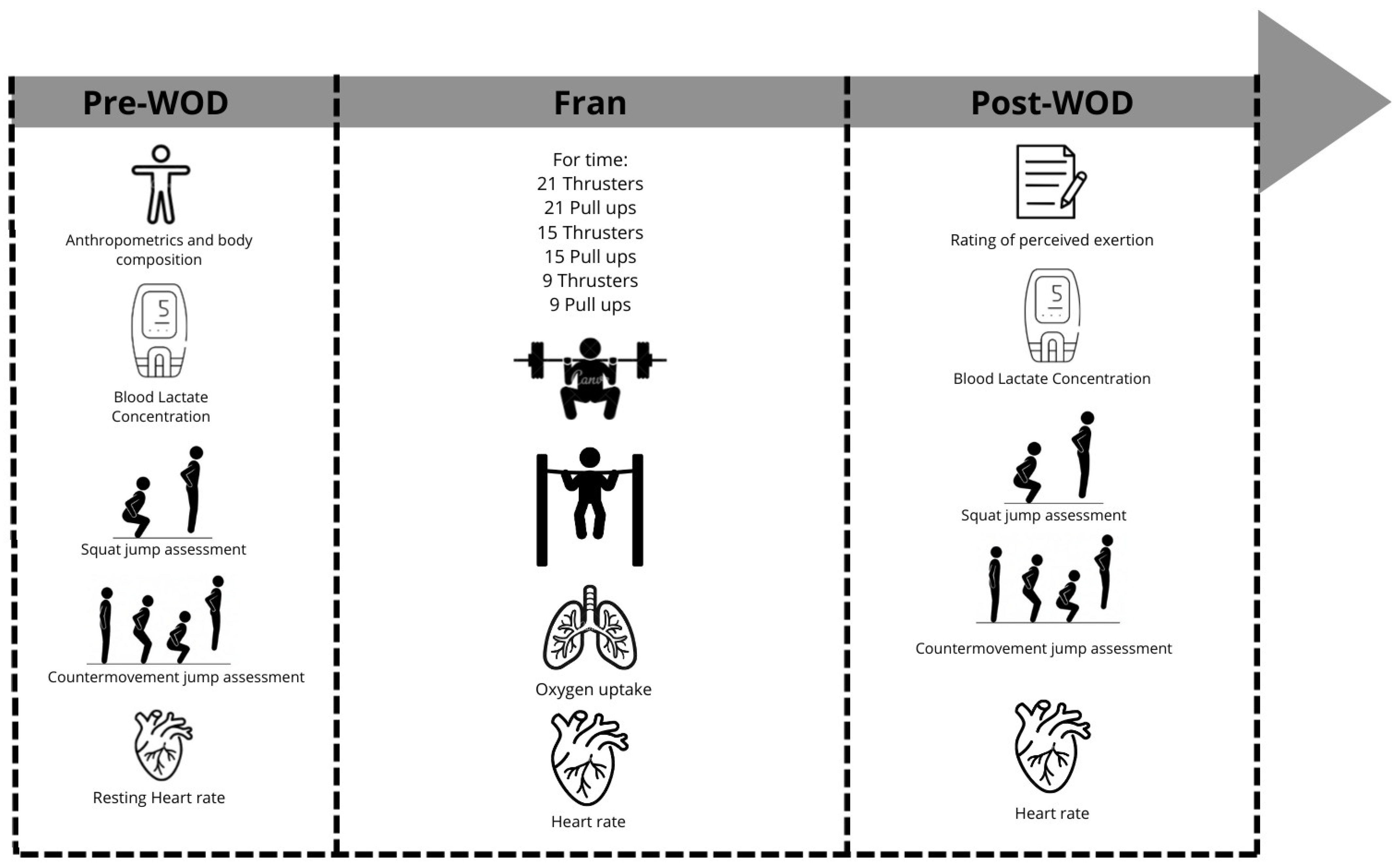
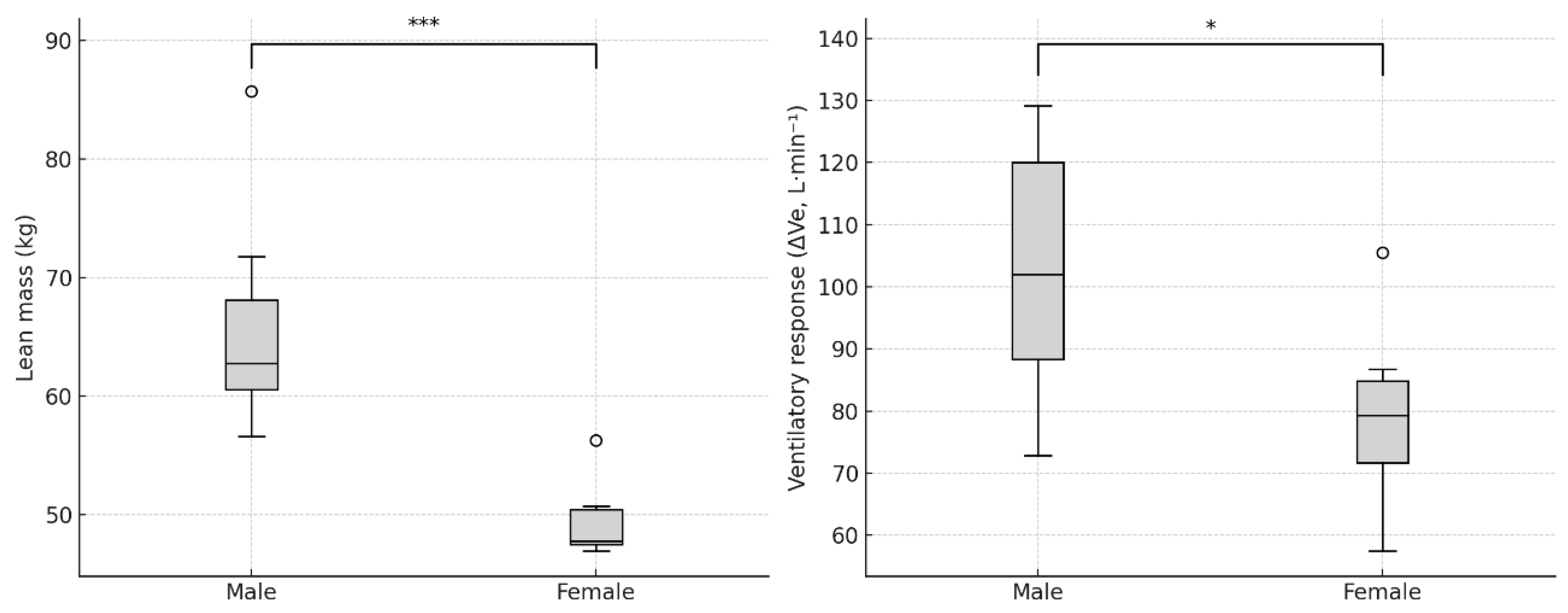

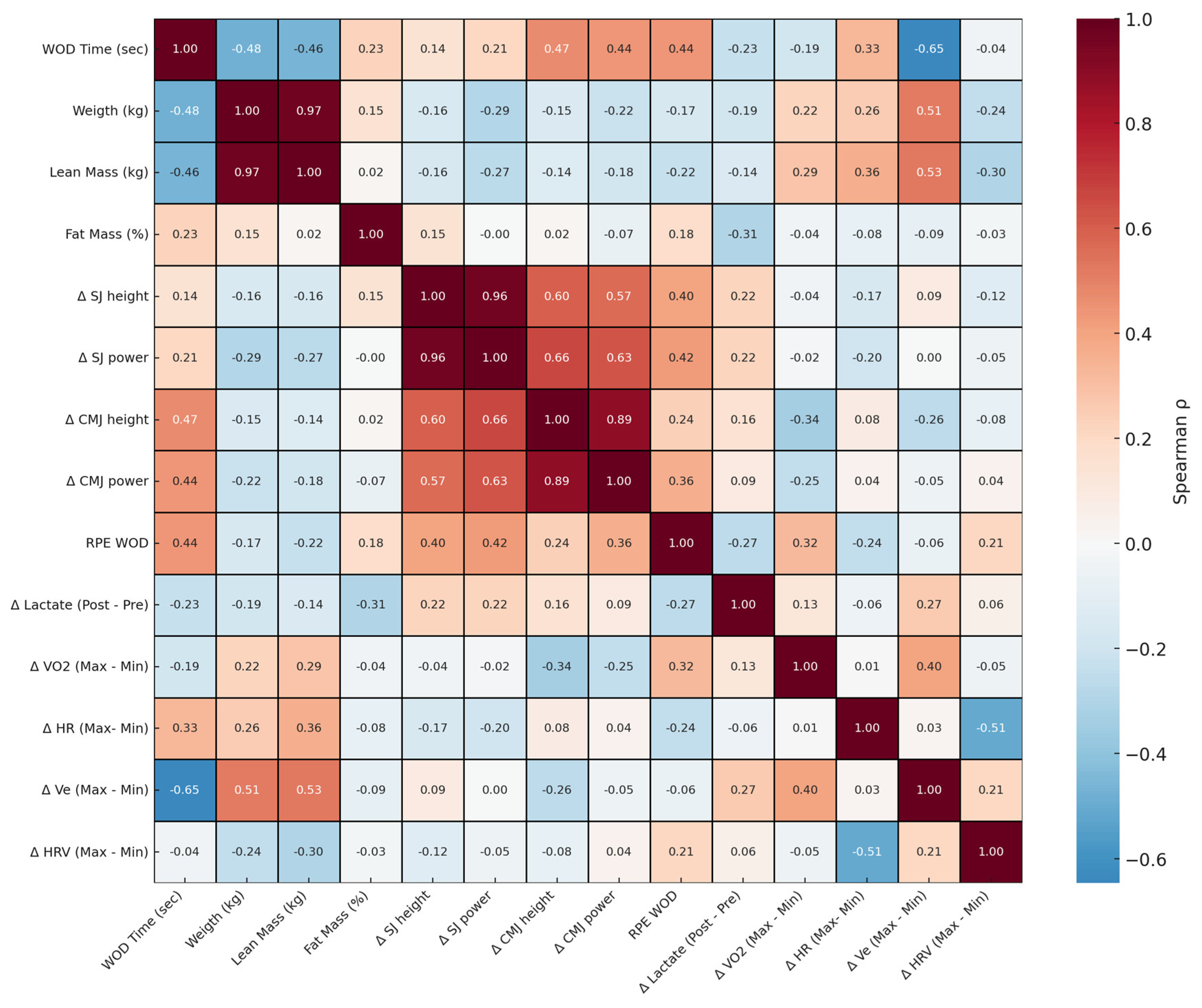
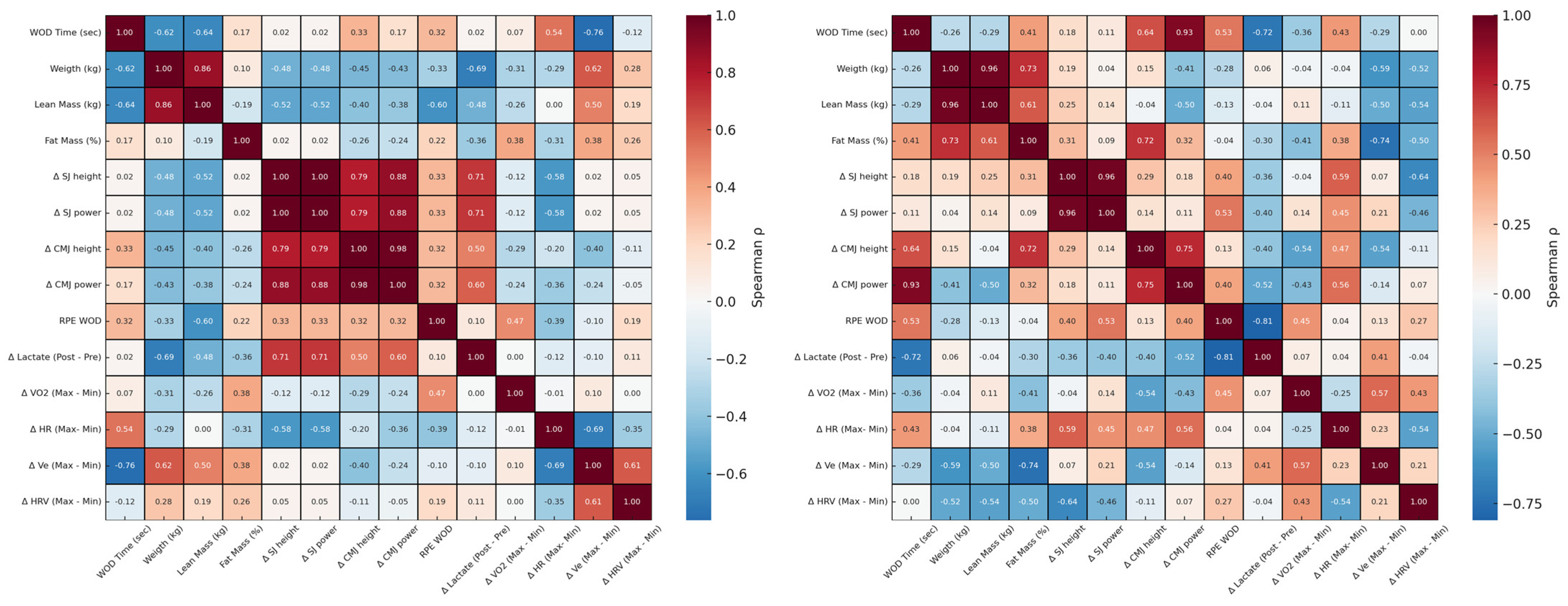
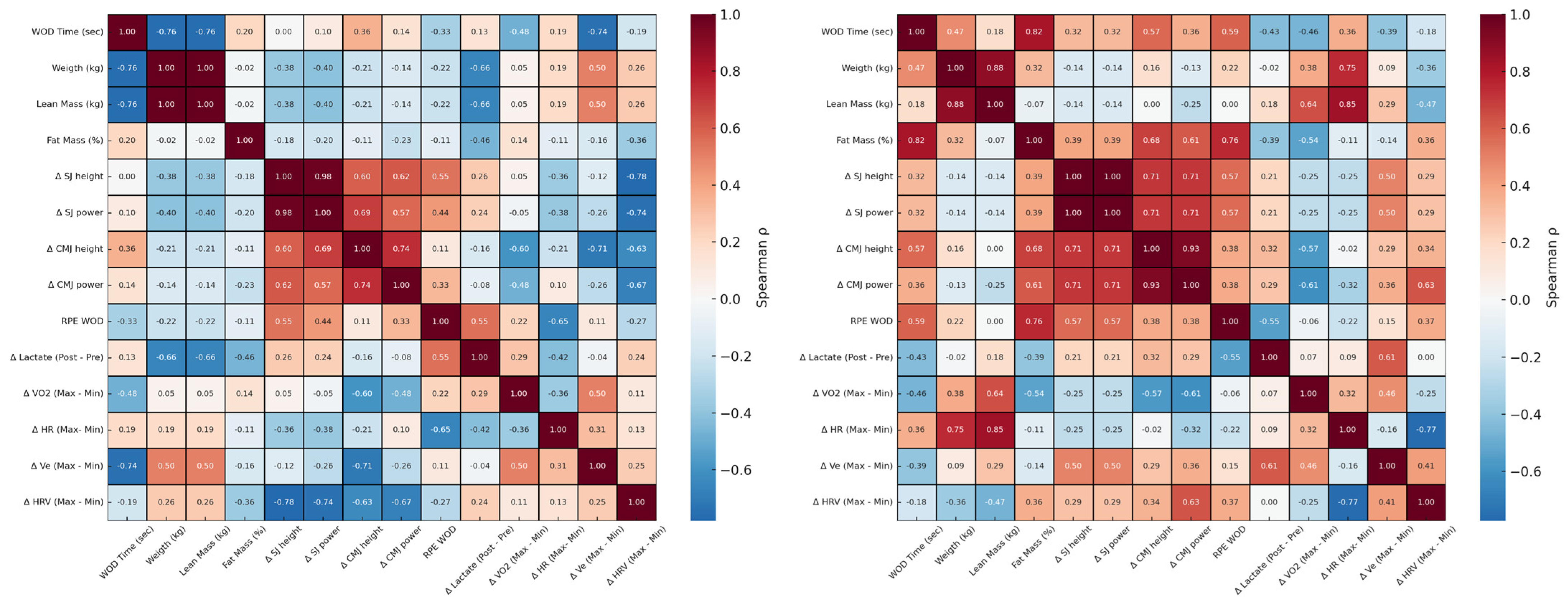
| WOD Time (s) | ΔSJ (cm) | ΔSJ (W) | ΔLactate [mmol/L] | ΔVO2 [mL/kg/min] | ΔHR (bpm) | ΔVe [L/min] | ΔHRV | ΔCMJ (W) | ΔCMJ (cm) | |
|---|---|---|---|---|---|---|---|---|---|---|
| Mean | 422.1 | −2.769 | −43.28 | 12.26 | 26.88 | 69.80 | 91.92 | 40.27 | −69.22 | −4.093 |
| SD | 173.2 | 3.278 | 52.83 | 1.563 | 5.501 | 16.07 | 21.59 | 19.51 | 61.85 | 3.232 |
| Min | 200.0 | −9.920 | −165.6 | 8.900 | 16.70 | 45.00 | 57.50 | 8.000 | −206.1 | −9.545 |
| Max | 840.0 | 2.879 | 35.90 | 14.39 | 38.30 | 90.00 | 129.1 | 66.00 | 20.80 | 1.643 |
Disclaimer/Publisher’s Note: The statements, opinions and data contained in all publications are solely those of the individual author(s) and contributor(s) and not of MDPI and/or the editor(s). MDPI and/or the editor(s) disclaim responsibility for any injury to people or property resulting from any ideas, methods, instructions or products referred to in the content. |
© 2025 by the authors. Licensee MDPI, Basel, Switzerland. This article is an open access article distributed under the terms and conditions of the Creative Commons Attribution (CC BY) license (https://creativecommons.org/licenses/by/4.0/).
Share and Cite
Malheiro, A.; Forte, P.; Rodríguez-Rosell, D.; Marques, D.L.; Marques, M.C. Exploratory Analysis of Physiological and Biomechanical Determinants of CrossFit Benchmark Workout Performance: The Role of Sex and Training Experience. Appl. Sci. 2025, 15, 10796. https://doi.org/10.3390/app151910796
Malheiro A, Forte P, Rodríguez-Rosell D, Marques DL, Marques MC. Exploratory Analysis of Physiological and Biomechanical Determinants of CrossFit Benchmark Workout Performance: The Role of Sex and Training Experience. Applied Sciences. 2025; 15(19):10796. https://doi.org/10.3390/app151910796
Chicago/Turabian StyleMalheiro, Alexandra, Pedro Forte, David Rodríguez-Rosell, Diogo L. Marques, and Mário C. Marques. 2025. "Exploratory Analysis of Physiological and Biomechanical Determinants of CrossFit Benchmark Workout Performance: The Role of Sex and Training Experience" Applied Sciences 15, no. 19: 10796. https://doi.org/10.3390/app151910796
APA StyleMalheiro, A., Forte, P., Rodríguez-Rosell, D., Marques, D. L., & Marques, M. C. (2025). Exploratory Analysis of Physiological and Biomechanical Determinants of CrossFit Benchmark Workout Performance: The Role of Sex and Training Experience. Applied Sciences, 15(19), 10796. https://doi.org/10.3390/app151910796










